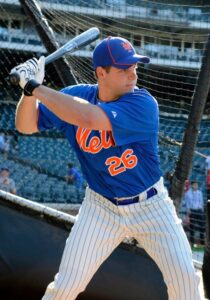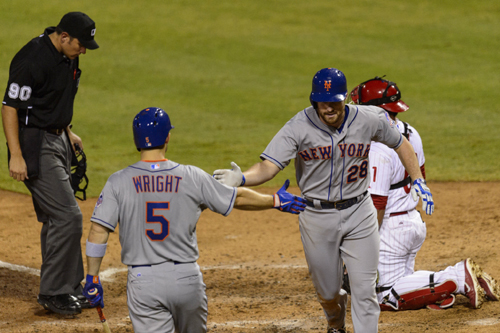The terms “discipline at the plate” and “patience at the plate” come up quite often when discussing hitters’ approaches at the plate—especially if you are a Mets fan. This notion that the organization is teaching their hitters to be more patient is a questionable one to say the least.
The two terms sound like they mean the same thing, but actually are quite different.
Patience refers to working a pitcher, seeing all his pitches, and waiting for the right pitch to jump on. The hitter basically is waiting for the pitcher to make a mistake. Some hitters excel using this strategy, while others flop. Patience naturally leads to a higher propensity to strike out, since you are taking at-bats into deep counts. The count itself is in the pitcher’s favor—three strikes versus four balls—which is more likely to occur?
You have to have an incredible amount of skill and mental toughness to hit using the strategy of patience. I would argue that this skill cannot even be taught. You either have what it takes to hit using this strategy, or you don’t.
Patience should be reserved for top-of-the-order hitters. The batting lineup is designed the way it is for a reason and is technically a division of labor. The top two hitters’ jobs are to work the pitchers and get on base. The middle-of-the-order hitters’ jobs are to drive in the top-of-the-order guys. The tail end of the lineup is generally reserved for defensive minded players, so not much is expected.
You cannot force your 3-4-5 hitter to be patient at the plate. Patience is not a strategy that can be forced on every player and that is why speed is not the only determining factor for guys hitting at the top of the order. Those middle-order hitters should show good plate discipline, but not be patient.
Discipline at the plate is the ability of the hitter to lay off pitches that are close, only swinging at pitches in the strike zone. This can be taught to hitters, and as they gain more experience at the plate, their plate discipline will improve. Of course, as with everything else, some hitters are better than others in this area.
If the Mets were teaching their hitters to have advanced plate discipline, I would think that is a sound strategy. However, forcing hitters to be more patient could turn very skilled top draft picks into career minor leaguers and wash outs.
Baseball America recently listed Brandon Nimmo as having the best strike-zone discipline in the organization. He walked 71 times in 110 games played, good for a 14.8% walk rate. However, Nimmo also struck out 27.3% of the time. After looking at the stats, I would argue with Baseball America that Nimmo is patient at the plate, but doesn’t necessarily have good plate discipline due to the amount he strikes out.
Nimmo’s stats in 2013 would have me believe the Mets should be grooming him for a leadoff spot in the lineup. He has a solid walk rate and on base percentage, and the speed to be a solid table setter in the future. But his strike out rate leads one to believe that he swings at pitches out of the strike-zone too often.
Now let’s look at a couple of guys in the Mets organization that have excellent plate discipline—Kevin Plawecki and Jayce Boyd.
 Plawecki should have earned the honors of best strike-zone discipline from Baseball America. Plawecki only struck out 8.8% of the time in 2013 with St. Lucie, and for his career, he is a guy that has only struck out about 10% of the time. He doesn’t walk as much, but his low strike out rate is a tell-tale sign of excellent plate discipline. Jayce Boyd is another guy that has about an 11% career strikeout rate but also earns walks at a similar clip.
Plawecki should have earned the honors of best strike-zone discipline from Baseball America. Plawecki only struck out 8.8% of the time in 2013 with St. Lucie, and for his career, he is a guy that has only struck out about 10% of the time. He doesn’t walk as much, but his low strike out rate is a tell-tale sign of excellent plate discipline. Jayce Boyd is another guy that has about an 11% career strikeout rate but also earns walks at a similar clip.
Boyd and Plawecki both had better wOBA than Nimmo in 2013 as well. This is a more accurate way to determine offensive value than OBP.
So which is better to have, strike-zone discipline or patience at the plate?
The answer is that it depends on what slot in the batting order the hitter is in. For my one and two hitters, I would prefer them to be more patient. I want them to get on base as much as possible, see as many pitches as possible so the heart of my order gets a good look at what the pitcher is bringing which also gets the pitcher tired. We know this comes with a higher propensity to strike out, but it’s a necessary evil.
The rest of the guys in the batting order should have good plate discipline. This means that they aren’t swinging at pitches out of the strike-zone, and not giving away at-bats.
In an article by Mike Puma in the New York Post last April, the title read GM’s Message Gets Through as Mets’ Plate Patience Paying Off.
Dave Hudgens stated in the article that “if you see 150 pitches a game, there is a good chance you are going to win.” Sorry, but seeing 150 pitches in a game doesn’t mean anything if it doesn’t generate runs. If this is so, then why don’t the Mets make the playoffs? Is it because other teams are more patient?
Sandy Alderson goes on to say in that same article that “It’s getting a good pitch to hit, and these guys are sorting through the pitches they are seeing to get something to hit. That approach is what really made us successful offensively in 2011 and the first half of 2012, and then we lost the approach. We couldn’t generate any offense in the second half of last year.”
In other words, Alderson and the Mets’ philosophy is taking the bat out of the hitters’ hands. They have the hitters waiting around for the beach ball to come down the middle of the plate or the pitcher to make a mistake. But what happens if the pitcher makes a mistake on the first pitch? What happens when that meatball comes down Broadway and you have trained your hitters like Pavlov’s dog to see a ton of pitches? Or better yet, what if that golden pitch never even comes?
 David Wright has a much better idea of what the philosophy should be, and what he describes is a hitter having good plate discipline and not necessarily patience: “You want kind of a controlled aggressive,” Wright said. “If you get a good pitch early in the count, we want you to pull the trigger, but you can’t go up there with the idea of trying to draw a walk. I think that’s the result of having a good at-bat and having a plan.”
David Wright has a much better idea of what the philosophy should be, and what he describes is a hitter having good plate discipline and not necessarily patience: “You want kind of a controlled aggressive,” Wright said. “If you get a good pitch early in the count, we want you to pull the trigger, but you can’t go up there with the idea of trying to draw a walk. I think that’s the result of having a good at-bat and having a plan.”
Thank goodness he understands. It’s probably why he performs so much better than the rest of the team offensively.
The Mets were tied for third in the major leagues with strike outs in 2013—1384 total. That number was good for one in every four at-bats. The Mets also had the sixth-lowest OBP in baseball last season (.306).
What that means is that being patient for the Mets, is not attributing to the team getting on base more, or scoring more runs. Trying to force the philosophy on players is not going to make it work.
A smart man that runs a team will evaluate the players on the roster, and then adapt a strategy that is best for those given players. This is why teams with lesser talent sometimes break through and have outstanding seasons. The Mets offensive philosophy cannot be unilateral. If you force Robert Griffin III to be a pocket passer, he won’t be as effective of a player—if you want a pocket passer you draft or trade for one.
The same rules apply in baseball. The Mets need to build an offensive philosophy around the players they have on the roster and not expect everyone to just be able to conform because they have proclaimed this as the philosophy. Either they adapt the philosophy to the current players, or bring in the players that will fit with the philosophy. That is the only solution.
While I know there is disdain amongst the fan base with regards to players who get walks, keep in mind that seven out of the top ten teams in the league in walks made the postseason in 2013. While the Mets’ team philosophy may not be the best fit for the current players on the roster, they may be on to something with regards to walks and plate discipline which contributes to overall team success.
















